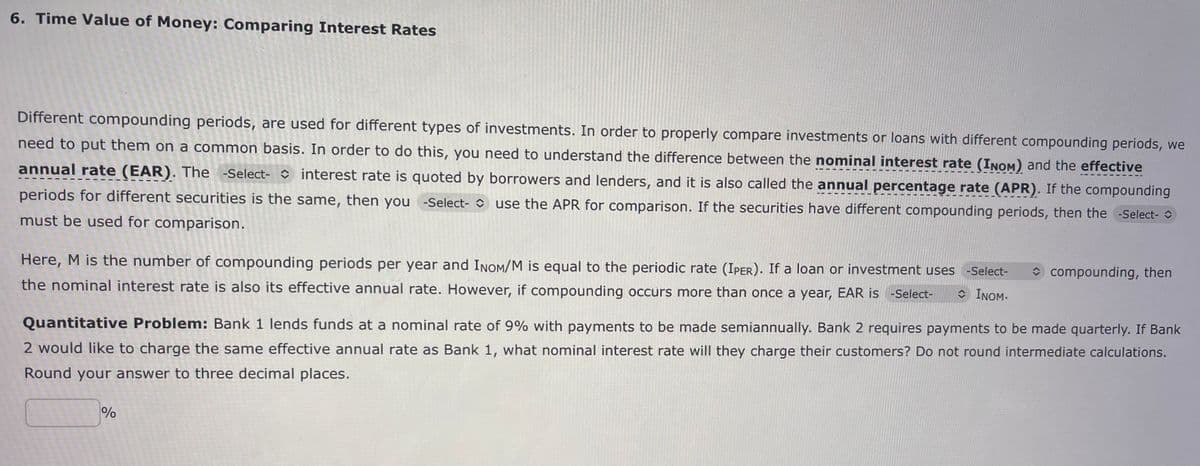Quantitative Problem: Bank 1 lends funds at a nominal rate of 9% with payments to be made semiannually. Bank 2 requires payments to be made quarterly. If Bank 2 would like to charge the same effective annual rate as Bank 1, what nominal interest rate will they charge their customers? Do not round intermediate calculations. Round your answer to three decimal places.
Quantitative Problem: Bank 1 lends funds at a nominal rate of 9% with payments to be made semiannually. Bank 2 requires payments to be made quarterly. If Bank 2 would like to charge the same effective annual rate as Bank 1, what nominal interest rate will they charge their customers? Do not round intermediate calculations. Round your answer to three decimal places.
Financial Reporting, Financial Statement Analysis and Valuation
8th Edition
ISBN:9781285190907
Author:James M. Wahlen, Stephen P. Baginski, Mark Bradshaw
Publisher:James M. Wahlen, Stephen P. Baginski, Mark Bradshaw
Chapter6: Accounting Quality
Section: Chapter Questions
Problem 4QE
Related questions
Question

Transcribed Image Text:6. Time Value of Money: Comparing Interest Rates
Different compounding periods, are used for different types of investments. In order to properly compare investments or loans with different compounding periods, we
need to put them on a common basis. In order to do this, you need to understand the difference between the nominal interest rate (INOM) and the effective
annual rate (EAR). The -Select- interest rate is quoted by borrowers and lenders, and it is also called the annual percentage rate (APR). If the compounding
periods for different securities is the same, then you -Select- use the APR for comparison. If the securities have different compounding periods, then the -Select-
must be used for comparison.
Here, M is the number of compounding periods per year and INOM/M is equal to the periodic rate (IPER). If a loan or investment uses -Select-
the nominal interest rate is also its effective annual rate. However, if compounding occurs more than once a year, EAR is -Select- INOM.
Quantitative Problem: Bank 1 lends funds at a nominal rate of 9% with payments to be made semiannually. Bank 2 requires payments to be made quarterly. If Bank
2 would like to charge the same effective annual rate as Bank 1, what nominal interest rate will they charge their customers? Do not round intermediate calculations.
Round your answer to three decimal places.
%
olo
compounding, then
Expert Solution
This question has been solved!
Explore an expertly crafted, step-by-step solution for a thorough understanding of key concepts.
This is a popular solution!
Trending now
This is a popular solution!
Step by step
Solved in 4 steps

Knowledge Booster
Learn more about
Need a deep-dive on the concept behind this application? Look no further. Learn more about this topic, finance and related others by exploring similar questions and additional content below.Recommended textbooks for you

Financial Reporting, Financial Statement Analysis…
Finance
ISBN:
9781285190907
Author:
James M. Wahlen, Stephen P. Baginski, Mark Bradshaw
Publisher:
Cengage Learning



Financial Reporting, Financial Statement Analysis…
Finance
ISBN:
9781285190907
Author:
James M. Wahlen, Stephen P. Baginski, Mark Bradshaw
Publisher:
Cengage Learning



Pfin (with Mindtap, 1 Term Printed Access Card) (…
Finance
ISBN:
9780357033609
Author:
Randall Billingsley, Lawrence J. Gitman, Michael D. Joehnk
Publisher:
Cengage Learning
